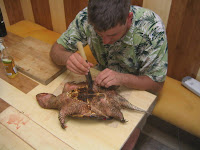 Pinger contemplates his discovery. While driving home through an undisclosed location in Virginia, he came across this beautiful creature. She was still moving when he found her, but fatally wounded, so he decided to bring her home and share the wealth.
Pinger contemplates his discovery. While driving home through an undisclosed location in Virginia, he came across this beautiful creature. She was still moving when he found her, but fatally wounded, so he decided to bring her home and share the wealth.My personal opinion is that she was probably already dead, since turtles can continue moving for quite awhile after death, but Andrew thought othewise. He thinks that since the turtle was moving when he put it in the freezer it is "freezer kill," as opposed to "road kill."
 The turtle's lower shell was surprisingly small, and demonstrated just how muscular these animals are. It looks as if Snappers have sacrificied underside protection for mobility, and apparently it's paid off.
The turtle's lower shell was surprisingly small, and demonstrated just how muscular these animals are. It looks as if Snappers have sacrificied underside protection for mobility, and apparently it's paid off.The cleaning instructions we found suggested slicing the skin around the lower shell and cutting the thin bridges connecting it to the upper shell first, so that's what Andrew did.
 As you can see, this female was loaded with eggs, which appear to be almost fully grown. There were 28 eggs overall, which took up a lot of room in the intestinal cavity. They appeared to be strung together by some kind of growing tissue. Trippy.
As you can see, this female was loaded with eggs, which appear to be almost fully grown. There were 28 eggs overall, which took up a lot of room in the intestinal cavity. They appeared to be strung together by some kind of growing tissue. Trippy.This turtle's shell was 10.25" long and 9.5" wide. According to the NWF field guide Snapping turtles can be from 8-18" long, making this one about medium sized. It also said their peak egg laying season is in June, although they can lay eggs from april until november. The largest recorded number of eggs is 83 (!), though 25-50 is normal. According to this guide they also travel some distance from water to lay eggs, which would explain why this one was crossing a road that wasn't near water. Strong swimmers, they have been known to travel over 2 miles in a few hours when displaced.

The turtle yeilded a surprising amount of meat as well as the 28 eggs. The leg meat was mostly dark, similar to beef or venison, while the neck meat was more like pork or poultry. Pinger located a recipe which recommended that the meat be parboiled to soften it. He cooked in a crockpot overnight, then proceeded to make a fine snapper stew, featuring standard vegetables (carrots, onions, etc.) and sherry as an important ingredient. The stew was incredibly tasty, and disappeared soon after it was made!
After seeing the turtle up close and being nourished from it, I can really see why Native Americans would have held this majestic creature in high regard. It has an ancient feel, like it was formed from the rocks and soil itself...and indeed each spring they emerge from the mud of swamps and streams. With formidable jaws, sharp claws and powerful muscles, as adults they probably know no predator other than humans. This pedatory dominance would give them a special place in lore and mythology.








